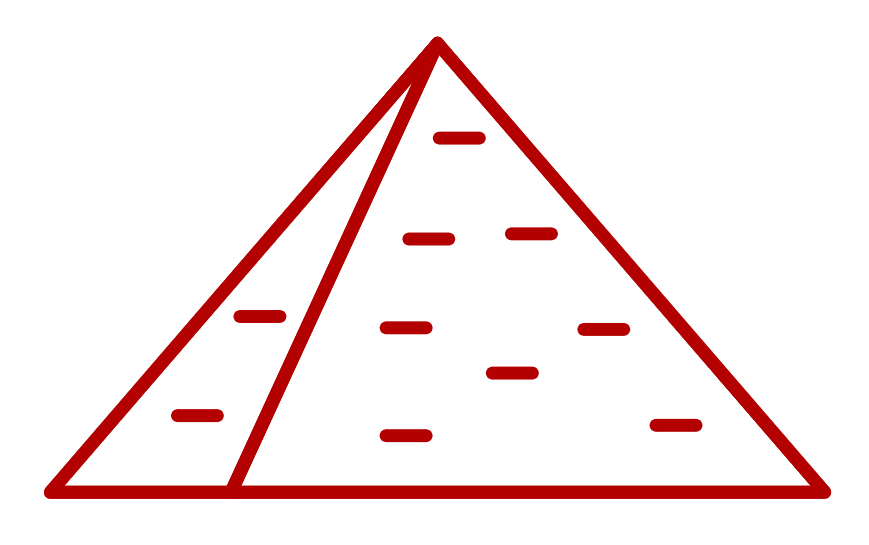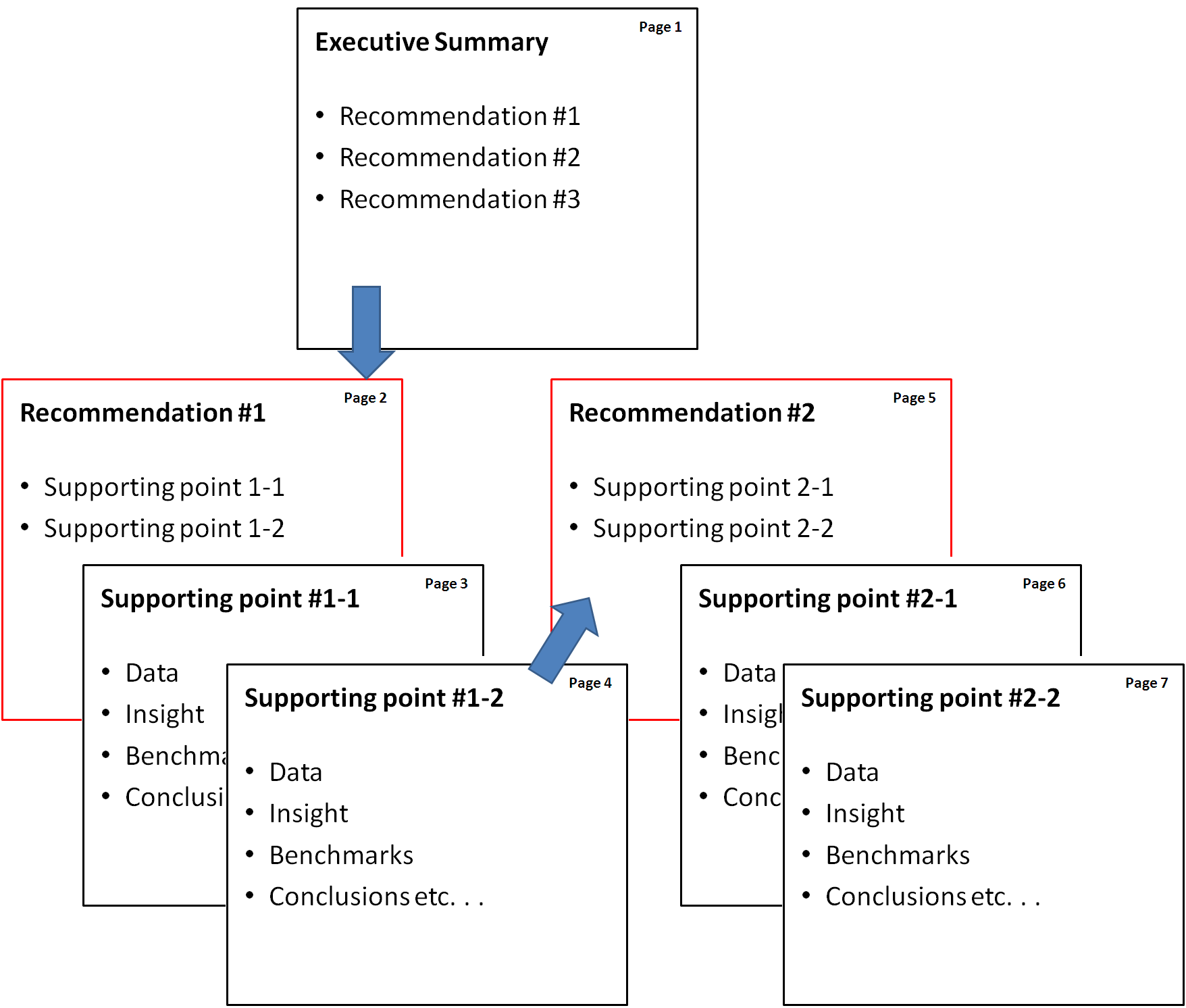Structure your thinking
This is the only way to present your ideas clearly to clients. One excellent tool is the pyramid principle by an ex-McKinsey consultant by the name of Barbara Minto. She authored a book called The Minto Pyramid Principle here (affiliate link) which essentially defined the way consultants structure most of their presentations. Most consultants will know what the pyramid principle is, even if they don’t know the author.
Pyramid Principle
Just like the name implies, the idea is that the logic looks like a pyramid. The main recommendation is on top. It is built on mid-level recommendations, each of which are supported by smaller facts, data, analysis, benchmarks etc . . .

In the graphic below you can see that the top of the pyramid (executive summary) has 3 recommendations. Each of those recommendations have supporting pages.
- Page 1 = executive summary
- Page 2-4 = recommendation #1 and supporting facts
- Page 5-7 = recommendation #2 and supporting facts
Conclusion first
It is a tops-down type of thinking that is very structured and how executives think. Big idea followed by smaller ideas. This format helps you “cut to the chase” quickly, which is good for many reasons:
- Grabs the executives (short) attention span; get your point out before they start asking questions
- Tracks logic easily: “I recommend A,B,C. Recommendation A is supported by facts 1,2,3”
- Allows the audience to focus on the areas they have the most interest
Yes, I know that most high-school term papers used a more bottom-up type of reasoning where the punchline was at the end of the 50 page paper. Trust me, that is not how you want to present in the boardroom. You do not want to start with lots of boring data points and save the good stuff to the end.
Caveat – exceptions to the rule
Two types of presentations where you won’t use the pyramid principle:
- An interim presentation of facts: In this case, the consultant is working with the client counterpart and walking them through information and some of the insights. Nothing too heavy. Not a recommendation. Just information sharing.
- A leave-behind deck: Here the consultant has a presentation that is meant to truly stand-on-its-own, so the font is smaller, and it is written in more long-form prose. It is more of a guide or playbook, than a hard-hitting million dollar recommendation.
Should I buy the book?
It’s up to you. It is $135 and bit of a boring read. If inclined, you can buy it directly from the author here. As a consulting trick, just go to amazon.com and read the 45 reviews posted. That will get you 80% of the way there.
Related Posts:
5 Consulting Courses
Available on Coursera

I recorded 5 courses on Coursera.
I’d like to share my experiences and advice on how we can all work like consultants; smarter and faster.
Pyramid principle in course #3.
You can audit the classes for free, or pay to get the full experience and certification.
Click any of the buttons.


Haha..The typical consultant’s guide….I still recollect how structured thinking, structured problem solving, mind/brain mapping and the pyramid principle was the key to a consultant readiness program i attended. In reality, we seldom get the opportunity to follow the deck advices provided. Copy an earlier deck format, replace content, modify, present 🙂
But looking back, I would agree that the program did its job of attempting to change the way we structure out thoughts…Good article…I invite you to visit, comment and follow my blog on consulting (www.thesmartconsultant.com). Thanks again for the article.
Agreed. Some times we are under pressure (from partners, clients, shortage of time, or just laziness) to simply look for previous examples so we can conveniently (ctrl H) find and replace names and calculations. Not good, but a bit of sad reality.
Certainly, some of that has to do with the type of project (Corporate strategy, BU strategy, process improvement, cost reduction, post-merger integration, valuations, business modeling, etc. . .), the timeline, and the risk-profile of the client. Lower tolerance for risk = best practices done somewhere before. Higher tolerance for risk = more innovation, free thinking.
Still a big fan of putting the executive summary (top of the pyramid) first in the PPT. Not everyone will agree with this, but has served me well so far.
So different to the Design Thinking principle.
Absolutely. That said, the pyramid principle is much less about exploration. It’s about aggregation, delineation, and basically putting chaos into buckets.
Design thinking – definitely doesn’t presume to know the boundaries of the problem. Instead, starts with the customers / patients / users and seeks to prototype and explore to an answer.
My understanding of the Pyramid Principle is it is a structure for organising reports and presentations. It can be also used for collecting information / research particularly if combined with Hypothesis Based Strategy.
I think you could undertake a Design Thinking project and still present your solution using the Pyramid Principle. It is a particularly useful way of structuring executive presentations. I would recommend a book called the ‘So What Strategy’ (also by McKinsey Consultants) which presents a similar approach but is much easier to read and explains the reason for using a Pyramid approach.
Nice, add it to my reading list. Thank you for the comment. Agree – don’t see why you could not have a more exploratory way to opening up the ideas, and prototpying quickly (a la Design Thinking), then use the somewhat rigid approach of Pyramid Principle to tell the story.